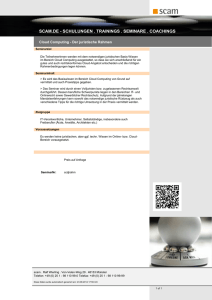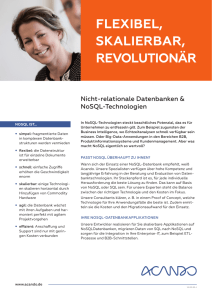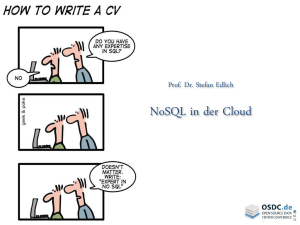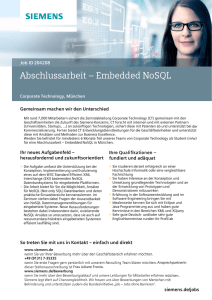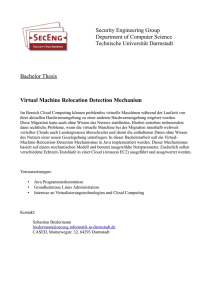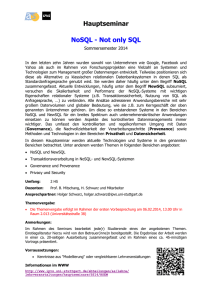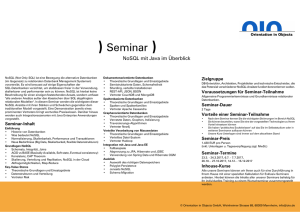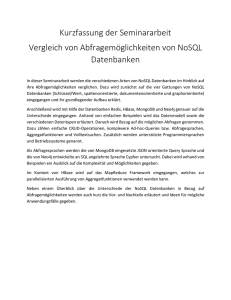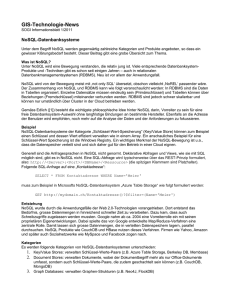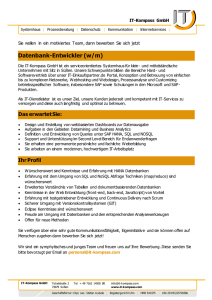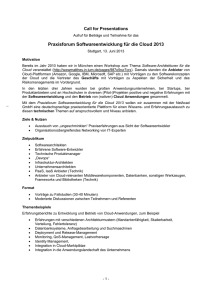Database as a Service 2015
Werbung
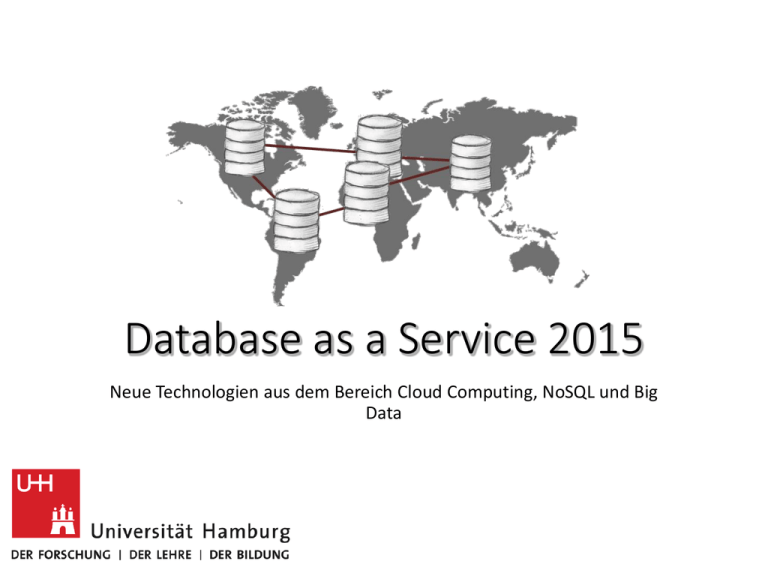
Database as a Service 2015 Neue Technologien aus dem Bereich Cloud Computing, NoSQL und Big Data Themenblöcke • Basistechnologien • Cloud Computing und DBaaS Plattformen • Big Data Plattformen • NoSQL Systeme 2 Ziele des Seminars Cloud Computing Big Data NoSQL Database-as-a-Service & Cloud Data Management 11.10.2015 3 Umbrüche in der Datenbankwelt 1. Cloud Computing: 11.10.2015 4 Umbrüche in der Datenbankwelt 2. NoSQL [Nathan Hurst, Visual Guide to NoSQL Systems] 11.10.2015 5 Umbrüche in der Datenbankwelt [451 Group Report, 2011] 2. NoSQL Polyglot Persistence 11.10.2015 6 Umbrüche in der Datenbankwelt 3. Big Data [Poepescu: myNoSQL Blog] 11.10.2015 7 Umbrüche in der Datenbankwelt 3. Big Data >150 Millionen Nutzer ~300k Timeline Querys pro Sekunde [http://www.infoq.com/presentations/Real-Time-Delivery-Twitter] 11.10.2015 8 Umbrüche in der Datenbankwelt 3. Big Data >1 Milliarde Nutzer ~1M Timeline Querys pro Sekunde [http://www.infoq.com/presentations/Facebook-News-Feed] 11.10.2015 9 Umbrüche in der Datenbankwelt NoSQL + Cloud + Big Data SimpleDB Cassandra >30M zahlende Nutzer ~1 Milliarde Stunden gestreamte Videos pro Monat Amazon S3, EC2, ... CDNs, REST-APIs Hadoop/Map-Reduce/EMR HBase [http://www.infoq.com/presentations/NoSQL-Netflix] 11.10.2015 10 Ziele des Seminars Cloud Computing Big Data NoSQL Ziel: Die drei neuen Trends und ihren Zusammenhang verstehen 11.10.2015 11 Themen 11.10.2015 Database as a Service – Seminar 2012 12 Basistechnologien 11.10.2015 Database as a Service – Seminar 2012 13 Cloud Computing - Terminologie Inhalt: • Unterscheidung zwischen • Software as a Service • Platform as a Service • Infrastrucutre as a Service • Public Clouds, Private Clouds, Hybrid Clouds • Praxisbeispiele • Abgrenzung zu Grid Computing – Ersetzt die Cloud das Grid? Basistechnologien 11.10.2015 14 Cloud Computing - Terminologie Referenzen: • http://www.infoq.com/presentations/Cloud-Introduction • P. Mell and T. Grance, “The NIST definition of cloud computing,” National Institute of Standards and Technology, vol. 53, no. 6, p. 50, 2009. • Lehner, Wolfgang, and Kai-Uwe Sattler. Web-scale Data Management for the Cloud. Springer, 2013. • M. Armbrust, A. Fox, R. Griffith, A. D. Joseph, R. Katz, A. Konwinski, G. Lee, D. Patterson, A. Rabkin, I. Stoica, and others, “A view of cloud computing,” Communications of the ACM, vol. 53, no. 4, pp. 50–58, 2010. • I. Foster, Y. Zhao, I. Raicu, and S. Lu, “Cloud computing and grid computing 360-degree compared,” in Grid Computing Environments Workshop, 2008. GCE’08, 2008, pp. 1–10. • I. Foster, C. Kesselman, J. M. Nick, and S. Tuecke, “The physiology of the grid,” in Grid computing, 2003, pp. 217–249. • C. Baun, M. Kunze, J. Nimis, and S. Tai, Cloud Computing: Web-basierte dynamische ITServices (Informatik im Fokus), 2nd ed. Springer, 2011. Basistechnologien 11.10.2015 15 DBaaS - Grundlagen Inhalt: • Mandantenfähigkeit: Shared machine, Shared Process, Shared Tables • Privacy/Verschlüsselung • Skalierbarkeit und Elastizität • Quality of Service und Workload Management • DBaaS-Konzepte für relationale Datenbanken: „Relational Cloud“ Basistechnologien 11.10.2015 16 DBaaS - Grundlagen Referenzen: • Vortrag „Creating Scalable Multitenant Architectures for the Cloud“: http://dbaas.wordpress.com/2011/05/14/creating-scalable-multitenant-architectures-for-the-cloud/ • Beispiele: http://dbaas.wordpress.com/database-as-a-service-dbaas-product-directory/ • M. Seibold and A. Kemper, “Database as a Service,” Datenbank-Spektrum, pp. 1–4, 2012. • C. A. Curino, E. P. C. Jones, R. A. Popa, N. Malviya, E. Wu, S. R. Madden, H. Balakrishnan, N. Zeldovich, and others, “Relational cloud: A database-as-a-service for the cloud,” 2011. • R. A. Popa, C. Redfield, N. Zeldovich, and H. Balakrishnan, “CryptDB: protecting confidentiality with encrypted query processing,” in Proceedings of the Twenty-Third ACM Symposium on Operating Systems Principles, 2011, pp. 85–100. • S. Krompass, D. Gmach, A. Scholz, S. Seltzsam, and A. Kemper, “Quality of service enabled database applications,” Service-Oriented Computing–ICSOC 2006, pp. 215–226, 2006. • S. Sakr, A. Liu, D. M. Batista, and M. Alomari, “A survey of large scale data management approaches in cloud environments,” Communications Surveys & Tutorials, IEEE, vol. 13, no. 3, pp. 311–336, 2011. • Lehner, Wolfgang, and Kai-Uwe Sattler. Web-scale Data Management for the Cloud. Springer, 2013. Basistechnologien 11.10.2015 17 Virtualisierung Inhalt: • Virtualisierung als Grundlage für isoliert laufende Systeme • Virtuelle Maschinen – Grundlagen: • Hardware Virtualisierung und Paravirtualisierung • Typ I und Typ II Hypervisor • Ein Beispiel-Hypervisor erklären, z.B: KVM, Xen, VmWare, HyperV • Ist Virtualisierung transparent für DBs? Basistechnologien 11.10.2015 18 Virtualisierung Referenzen: • Vorlesungsskript: http://pages.cs.wisc.edu/~remzi/OSFEP/ • Podcast: http://cre.fm/cre092 • P. Barham, B. Dragovic, K. Fraser, S. Hand, T. Harris, A. Ho, R. Neugebauer, I. Pratt, and A. Warfield, “Xen and the art of virtualization,” in ACM SIGOPS Operating Systems Review, 2003, vol. 37, pp. 164–177. • K. Adams and O. Agesen, “A comparison of software and hardware techniques for x86 virtualization,” in ACM SIGOPS Operating Systems Review, 2006, vol. 40, pp. 2–13. • A. Kivity, Y. Kamay, D. Laor, U. Lublin, and A. Liguori, “kvm: the Linux virtual machine monitor,” in Proceedings of the Linux Symposium, 2007, vol. 1, pp. 225– 230. • Potentielles Problem für Durability: fsync Verhalten http://petercai.com/virtualization-is-bad-for-database-integrity/ Basistechnologien 11.10.2015 19 REST Services Inhalt: • Representational State Transfer – HTTP als Protokoll für serviceorientierte Architekturen • Grundlagen von HTTP • REST Constraints, z.B. Statuslosigkeit • Praxisbeispiel: eine gelungene REST-API erläutern, z.B. Twitter, Facebook, Atom Publishing Protocol, Microsoft OData, Google Gdata, etc. Basistechnologien 11.10.2015 20 REST Services Referenzen: • Vortrag: http://www.infoq.com/presentations/REST-AndNow-for-Something-Completely-Different • R. T. Fielding, “Architectural styles and the design of network-based software architectures,” University of California, 2000. • S. Tilkov, REST und HTTP: Einsatz der Architektur des Web für Integrationsszenarien. dpunkt, 2011. • How REST replaced SOAP on the web: http://www.infoq.com/articles/rest-soap Basistechnologien 11.10.2015 21 Content Delivery Networks (CDNs) Inhalt: • Der Schlüssel für schnelle Cloud Services und Websites • Ziel: Minimierung der Latenz zum Client und Entlastung des Services • Beispiele: Cloudfront, Akamai • Techniken (u.a.): • DNS-Anycasting, URL-Rewriting, Edge-Site Includes Basistechnologien 11.10.2015 22 Content Delivery Networks (CDNs) Referenzen: • Amazon Cloudfront Doc: http://aws.amazon.com/de/documentation/cloudfront/ • J. Dilley, B. Maggs, J. Parikh, H. Prokop, R. Sitaraman, and B. Weihl, “Globally distributed content delivery,” Internet Computing, IEEE, vol. 6, no. 5, pp. 50–58, 2002. • M. Pathan and R. Buyya, “A taxonomy of CDNs,” Content delivery networks, pp. 33–77, 2008. • Gilbert and Held, A Practical Guide to Content Delivery Networks, Second Edition, 2nd ed. CRC Press, 2012. • R. Buyya, M. Pathan, and A. Vakali, Content Delivery Networks, 1st ed. Springer Berlin Heidelberg, 2008. Basistechnologien 11.10.2015 23 Cloud Computing Plattformen 11.10.2015 24 Amazon Web Services Inhalt: • Derzeit größte Cloud Plattform mit diveresen Diensteen (u.a.): • • • • • • Elastic Compute Cloud (EC2) Simple Storage Service (S3) SimpleDB & DynamoDB & RDS Elastic Load Balancer (ELB) Beanstalk Route 53 Cloud Computing Plattformen 11.10.2015 25 Amazon Web Services Referenzen: • Online Dokumentation: http://aws.amazon.com/de/ • Präsentation: http://www.infoq.com/presentations/amazon-webservices und http://www.infoq.com/presentations/Deploying-onAmazon-EC2 • J. van Vliet and F. Paganelli, Programming Amazon EC2. O’Reilly Media, 2011. • C. Baun, M. Kunze, J. Nimis, and S. Tai, Cloud Computing: Web-basierte dynamische IT-Services (Informatik im Fokus), 2nd ed. Springer, 2011. Cloud Computing Plattformen 11.10.2015 26 Amazon SimpleDB, DynamoDB, S3, RDS Inhalt: • Database as a Service in der Amazon Cloud • SimpleDB: • Eingeschränkte aber schnelle Querys • Eventually Consistent, Pay-as-you-go, REST-API • DynamoDB: • Automatische Partionierung, SSDs statt HDDs • Simple Storage Service (S3): Blobs/Dateien • Relational Data Service (RDS): klassisches Oracle, MS-SQL, MySQL Datenbanksystem Cloud Computing Plattformen 11.10.2015 27 Amazon SimpleDB, DynamoDB, S3, RDS Referenzen: • AWS Online Dokumentation: http://aws.amazon.com/de/ • SimpleDB: http://aws.amazon.com/de/documentation/simpledb/ • DynamoDB: http://aws.amazon.com/de/dynamodb • RDS: http://aws.amazon.com/de/documentation/rds/ • S3: http://aws.amazon.com/de/documentation/s3/ • J. van Vliet and F. Paganelli, Programming Amazon EC2. O’Reilly Media, 2011. Cloud Computing Plattformen 11.10.2015 28 Google App Engine Inhalt: • Erläuterung des Google PaaS • Grundlagen der Anwendungsarchitektur in der GAE • GAE DataStore – die Schnittstelle zum Google BigTable Backend (die größte DB der Welt) Cloud Computing Plattformen 11.10.2015 29 Google App Engine Referenzen: • Präsentation auf der Google IO 2012: http://www.youtube.com/watch?feature=player_embedded&v=uy0nAL QEAM4 • Vortrag „SQL vs NoSQL“ auf der Google IO: http://www.youtube.com/watch?v=rRoy6I4gKWU • Docs: https://developers.google.com/appengine/docs/ • App Engine Datastore: https://developers.google.com/appengine/docs/java/datastore/?hl=de • M. C. Chu-Carroll, Code in the Cloud: Programming Google AppEngine. Pragmatic Programmers, 2011. • D. Sanderson, Programming Google App Engine, 2. Auflage. O’Reilly Media, 2012. Cloud Computing Plattformen 11.10.2015 30 Windows Azure Inhalt: • Überblick über die Services: • Anwendungsentwicklung – Programmiersprachen und SDKs • Datenspeicherung • Integration mit In-House Lösungen • Diverse Möglichkeiten zur Persistenz: Azure Blobs, Tables, Queues und SQL Azure • Architektur und Aufbau der Azure Cloud Cloud Computing Plattformen 11.10.2015 31 Windows Azure Referenzen: • Vortrag „Getting started with Windows Azure“: http://channel9.msdn.com/Events/windowsazure/learn/KeynoteGetting-Started-with-Windows-Azure • David Chappell, Whitepapers: http://www.davidchappell.com/writing/white_papers.php • Windows Azure Storage http://www.davidchappell.com/writing/white_papers/Windows_Azure_ Data_v1.0.pdf • S. Krishnan, Programming Windows Azure: Programming the Microsoft Cloud, 1st ed. O’Reilly Media, 2010. Cloud Computing Plattformen 11.10.2015 32 Eucalyptus Inhalt: • Elastic Utility Computing Architecture for Linking Your Programs To Useful Systems • Open Source Implementierung von Amazon EC2 • Verteilte Server-Architektur • Grundidee: Abstraktionslayer für Anfragen wie: „Stelle eine neue virtuelle Maschine bereit“ • Abgrenzung zu OpenNebula und OpenStack Cloud Computing Plattformen 11.10.2015 33 Eucalyptus Referenzen: • Vortag Velocity Conference 2008: http://blip.tv/oreilly-velocityconference/rich-wolski-eucalyptus-elastic-utility-computingarchitecture-for-linking-your-programs-to-useful-systems-1026899 • P. Sempolinski and D. Thain, “A comparison and critique of eucalyptus, opennebula and nimbus,” in Cloud Computing Technology and Science (CloudCom), 2010 IEEE Second International Conference on, 2010, pp. 417–426. • D. Nurmi, R. Wolski, C. Grzegorczyk, G. Obertelli, S. Soman, L. Youseff, and D. Zagorodnov, “The eucalyptus open-source cloud-computing system,” in Cluster Computing and the Grid, 2009. CCGRID’09. 9th IEEE/ACM International Symposium on, 2009, pp. 124–131. Cloud Computing Plattformen 11.10.2015 34 OpenStack Inhalt: • Private IaaS Cloud Plattform (begründet von Rackspace und NASA) • Compute (Nova) • Object Storage (Swift), Block Storage (Cinder) • Networking (Neutron) Cloud Computing Plattformen 11.10.2015 35 Openstack Referenzen: • Videos von der Konferenz OpenStack Summit: http://www.openstack.org/summit/portland-2013/session-videos/?day=1 • Documentation: http://docs.openstack.org/ • Operating OpenStack (frei verfügbares Buch): http://docs.openstack.org/trunk/openstack-ops/openstack-ops-manual-trunk.pdf • Einführender Blog-Artikel: http://ken.pepple.info/openstack/2012/09/25/openstackfolsom-architecture/ • Wen, Xiaolong, et al. "Comparison of open-source cloud management platforms: OpenStack and OpenNebula." Fuzzy Systems and Knowledge Discovery (FSKD), 2012 9th International Conference on. IEEE, 2012. Cloud Computing Plattformen 11.10.2015 36 Big Data Processing 11.10.2015 37 GFS und HDFS Inhalt: • Verteiltes hochskalierbares Dateisystem • HDFS (Hadoop Projekt) als Implementierung von GFS (Google) • Grundlage für Map-Reduce • Namenode-Datanode Architektur Big Data Processing 11.10.2015 38 GFS und HDFS Referenzen: • Intro to HDFS talk: http://www.youtube.com/watch?v=ziqx2hJY8Hg • Ghemawat, Sanjay, Howard Gobioff, and Shun-Tak Leung. "The Google file system." ACM SIGOPS Operating Systems Review. Vol. 37. No. 5. ACM, 2003. • Vorlesung Uni Leipzig zu Cloud Data Management: http://dbs.unileipzig.de/de/stud/2012ss/cdm • T. White, Hadoop: The definitive guide. Yahoo Press, 2010. • D. Borthakur, “The hadoop distributed file system: Architecture and design,” Hadoop Project Website, vol. 11, p. 21, 2007. Big Data Processing 11.10.2015 39 MapReduce und Hadoop Inhalt: • Revolution der verteilten Datenverarbeitung durch Google • Grundlagen: • Map-Phase, Shuffle-Phase, Reduce-Phase • Beispielalgorithmen, z.B. Word-Count • Hadoop die Open-Source Implementierung: • Job-Tracker, Worker, Hadoop Distributed Filesystem • As-a-Service: Amazon Elastic Map Reduce Big Data Processing 11.10.2015 40 MapReduce und Hadoop Referenzen: • Vortrag über das Hadoop Ökosystem: http://www.infoq.com/presentations/Hadoop-Introduction • Vorlesung Uni Leipzig zu Cloud Data Management: http://dbs.unileipzig.de/de/stud/2012ss/cdm • Lehner, Wolfgang, and Kai-Uwe Sattler. Web-scale Data Management for the Cloud. Springer, 2013. • J. Dean and S. Ghemawat, “MapReduce: simplified data processing on large clusters,” Communications of the ACM, vol. 51, no. 1, pp. 107–113, 2008. • T. White, Hadoop: The definitive guide. Yahoo Press, 2010. • D. Borthakur, “The hadoop distributed file system: Architecture and design,” Hadoop Project Website, vol. 11, p. 21, 2007. Big Data Processing 11.10.2015 41 Pig & Hive Inhalt: • Anfragesprachen als Layer über MapReduce • Hive: • HiveQL – eine SQL ähnliche Anfragesprache • Queryverarbeitung und Übersetzung in MapReduce • Pig: • Pig Latin - Prozedurale Anfragesprache • Vergleich, Vor- und Nachteile, Amazon EMR Big Data Processing 11.10.2015 42 Pig & Hive Referenzen: • Vorlesung Uni Leipzig zu Cloud Data Management: http://dbs.unileipzig.de/de/stud/2012ss/cdm • C. Olston, B. Reed, U. Srivastava, R. Kumar, and A. Tomkins, “Pig latin: a not-soforeign language for data processing,” in Proceedings of the 2008 ACM SIGMOD international conference on Management of data, 2008, pp. 1099–1110. • A. Thusoo, J. S. Sarma, N. Jain, Z. Shao, P. Chakka, S. Anthony, H. Liu, P. Wyckoff, and R. Murthy, “Hive: a warehousing solution over a map-reduce framework,” Proceedings of the VLDB Endowment, vol. 2, no. 2, pp. 1626–1629, 2009. • Hive: http://hive.apache.org/ • Pig: http://pig.apache.org/ Big Data Processing 11.10.2015 43 Dremel (Google BigQuery) Inhalt: • Idee: wenn man den berüchtigten „Full Table Scan“ nicht vermeiden kann muss man ihn optimieren • Ziel: SQL Querys auf GigaBytes bis PetaBytes von Daten in wenigen Sekunden • Interne Realisierung, Verteilungsarchitektur • As-a-Service: BigQuery Big Data Processing 11.10.2015 44 Dremel (Google BigQuery) Referenzen: • Google IO Vortrag 2012 zu BigQuery: http://www.youtube.com/watch?v=QI8623HlYd4 • S. Melnik, A. Gubarev, J. J. Long, G. Romer, S. Shivakumar, M. Tolton, and T. Vassilakis, “Dremel: interactive analysis of web-scale datasets,” Proceedings of the VLDB Endowment, vol. 3, no. 1–2, pp. 330–339, 2010. • Apache Drill: http://bigdatacraft.com/archives/374 Big Data Processing 11.10.2015 45 Google Pregel Inhalt: • Programmiermodell für sehr große Graphenprobleme • Message-Passing zwischen Knoten des Graphens • Jeder Knoten hat lokale Funktionen, die definiert werden können • Implementierung von Googles PageRank: 15 Zeilen Code Big Data Processing 11.10.2015 46 Google Pregel Referenzen: • Einstieg: http://www.quora.com/Pregel/What-are-the-mainconcepts-behind-Googles-Pregel • G. Malewicz, M. H. Austern, A. J. C. Bik, J. C. Dehnert, I. Horn, N. Leiser, and G. Czajkowski, “Pregel: a system for large-scale graph processing,” in Proceedings of the 2010 international conference on Management of data, 2010, pp. 135–146. • Ricky Ho, Blogpost: http://horicky.blogspot.de/2010/07/google-pregel-graphprocessing.html Big Data Processing 11.10.2015 47 Berkley Stack Inhalt: • BDAS ([Badass]), the Berkeley Data Analytics Stack • Spark: MapReduce mit Optimierungen für iterative Ausführungen • Shark: SQL-to-MapReduce • BlinkDB: SQL mit beschränkten Fehlerraten und Antwortzeiten • MLBase: Deklaratives Machine-Learning Framework • 2 davon aussuchen und detailliert behandeln Big Data Processing 11.10.2015 48 Berkley Stack Referenzen: • http://de.slideshare.net/AmazonWebServices/bdt305-tranformingbigdata • Agarwal, Sameer, et al. "BlinkDB: queries with bounded errors and bounded response times on very large data." Proceedings of the 8th ACM European Conference on Computer Systems. ACM, 2013. • Shenker, Scott, et al. "Shark: SQL and Rich Analytics at Scale." (2012) • Kraska, Tim, et al. "MLbase: A Distributed Machine-learning System." CIDR. 2013. • Engle, Cliff, et al. "Shark: fast data analysis using coarse-grained distributed memory." Proceedings of the 2012 ACM SIGMOD International Conference on Management of Data. ACM, 2012. Big Data Processing 11.10.2015 49 NoSQL Systeme 11.10.2015 50 NoSQL – Terminologie und Historie Inhalt: • Was bedeutet NoSQL und warum ist die Bezeichnung schlecht? • Kategorien von NoSQL Systemen (unterschiedliche Taxonomien): • • • • Key-Value Stores Dokumentendatenbanken Graphendatenbanken Wide Column Stores NoSQL Systeme 11.10.2015 51 NoSQL – Terminologie und Historie Referenzen: • Vortrag: NoSQL Database Technology: A Survey and Comparison of Systems http://www.infoq.com/presentations/NoSQL-Survey-Comparison • C. Strauch, U. L. S. Sites, and W. Kriha, “NoSQL databases,” Lecture Notes, Stuttgart Media University, 2011. • R. Cattell, “Scalable sql and nosql data stores,” ACM SIGMOD Record, vol. 39, no. 4, pp. 12–27, 2011. • P. J. Sadalage, NoSQL Distilled: A Brief Guide to the Emerging World of Polyglot Persistence. AddisonWesley Professional. • S. Edlich, NoSQL Einstieg in die Welt nichtrelationaler Web-2.0-Datenbanken. München: Hanser, 2010. • E. Redmond, J. Wilson, and J. Carter, Seven databases in seven weeks : a guide to modern databases and the NoSQL movement. Lewisville, Tex.; Farnham: Pragmatic Bookshelf ; O’Reilly [distributor], 2012. • M. Stonebraker, “SQL databases v. NoSQL databases,” Communications of the ACM, vol. 53, no. 4, pp. 10–11, 2010. NoSQL Systeme 11.10.2015 52 CAP Theorem und Skalierbarkeit Inhalt: • Die Unvereinbarkeit von Consistency, Availability und Partition Tolerance • Unterschiede zu ACID • Warum skalieren relationale DBs schlecht? • Konsequenzen: BASE, Eventual Consistency, Abgeschwächte Konsistenz, z.B. Read-Your-Writes NoSQL Systeme 11.10.2015 53 CAP Theorem und Skalierbarkeit Referenzen: • Teaser: http://adam.heroku.com/past/2009/7/6/sql_databases_dont_scale/ • Werner Vogels (Amazon CTO), „Eventually Consistent“: http://www.allthingsdistributed.com/2007/12/eventually_consistent.html • S. Gilbert and N. Lynch, “Brewer’s conjecture and the feasibility of consistent, available, partition-tolerant web services,” ACM SIGACT News, vol. 33, no. 2, pp. 51–59, 2002. • E. A. Brewer, “Towards robust distributed systems,” in Proceedings of the Annual ACM Symposium on Principles of Distributed Computing, 2000, vol. 19, pp. 7–10. • R. Ramakrishnan, “CAP and Cloud Data Management,” Computer, vol. 45, no. 2, pp. 43–49, 2012. • E. Brewer, “CAP twelve years later: How the,” Computer, vol. 45, no. 2, pp. 23– 29, 2012. NoSQL Systeme 11.10.2015 54 Google BigTable Inhalt: • Das Datenbankbackend von Google • Verteilungsarchitektur: Sharding (Partitionierung) • Schnittstelle: nichttransaktionaler Zugriff • Konsistenzmodell: Replikation, eventually consistent • Open-Source Implementierung: HBase • MapReduce Querys, Verteilte Datenhaltung in HDFS • Anfrage durch REST-API oder RPC (Thrift, Avro) NoSQL Systeme 11.10.2015 55 Google BigTable Referenzen: • Jeff Dean, Vortrag http://video.google.com/videoplay?docid=7278544055668715642 • Ricky Ho, Blog http://horicky.blogspot.de/2010/10/bigtable-model-withcassandra-and-hbase.html • F. Chang, J. Dean, S. Ghemawat, W. C. Hsieh, D. A. Wallach, M. Burrows, T. Chandra, A. Fikes, and R. E. Gruber, “Bigtable: A distributed storage system for structured data,” ACM Transactions on Computer Systems (TOCS), vol. 26, no. 2, p. 4, 2008. • HBase Vortag http://www.infoq.com/presentations/HBase-at-Facebook • L. George, HBase: The Definitive Guide: The Definitive Guide. O’Reilly Media, 2011. NoSQL Systeme 11.10.2015 56 Amazon Dynamo Inhalt: • Hochperformanter, verteilter Key-Value Store • Verschmelzung raffinierter Algorithmen: • Merkle-Trees, Gossip Protokoll • Consistent Hashing, Vector Clocks • Inspiriert Voldemort, Riak, Dynomite • Besonders gut: Riak • Wählbare Konsistenz, Agnostisch gegenüber Speichertechnik (z.B. Dateisystem, Datenbanksystem) NoSQL Systeme 11.10.2015 57 Amazon Dynamo Referenzen: • Einstieg: http://www.infoq.com/presentations/Riak-Core • Vortrag „Dynamo is not just for Datastores“ http://www.infoq.com/presentations/Dynamo-Is-Not-Just-for-Datastores • G. DeCandia, D. Hastorun, M. Jampani, G. Kakulapati, A. Lakshman, A. Pilchin, S. Sivasubramanian, P. Vosshall, and W. Vogels, “Dynamo: amazon’s highly available key-value store,” in ACM SIGOPS Operating Systems Review, 2007, vol. 41, pp. 205–220. • C. Strauch, U. L. S. Sites, and W. Kriha, “NoSQL databases,” Lecture Notes, Stuttgart Media University, 2011. • E. Redmond, J. Wilson, and J. Carter, Seven databases in seven weeks : a guide to modern databases and the NoSQL movement. Lewisville, Tex.; Farnham: Pragmatic Bookshelf ; O’Reilly [distributor], 2012. NoSQL Systeme 11.10.2015 58 MongoDB Inhalt: • Populäre Dokumentendatenbank • Funktionalität: • • • • Speicherung von JSON Dokumenten Komplexe Queries auf Dokuementen Replikation und Sharding (Kontrollierbare Verfügbarkeit und Performance) Map-Reduce Querys NoSQL Systeme 11.10.2015 59 MongoDB Referenzen: • Teaser-Vortrag http://www.infoq.com/presentations/Why-I-ChoseMongoDB-for-Guardian • MongoDB Architecture, Ricky Ho, Blog http://horicky.blogspot.de/2012/04/mongodb-architecture.html • MongoDB Docs: http://www.mongodb.org/display/DOCS/Home • C. Strauch, U. L. S. Sites, and W. Kriha, “NoSQL databases,” Lecture Notes, Stuttgart Media University, 2011. • K. Chodorow and M. Dirolf, MongoDB: the definitive guide. O’Reilly Media, 2010. NoSQL Systeme 11.10.2015 60 CouchDB Inhalt: • Webnahe Dokumentendatenbank • Eigenschaften: • • • • Map-Reduce Views mit JavaScript REST API Replikation und Konflikterkennung Embedded Mode NoSQL Systeme 11.10.2015 61 CouchDB Referenzen: • Damien Katz: http://www.infoq.com/presentations/katz-couchdb-and-me • Will LeinWeber, Vortrag http://www.infoq.com/presentations/couchdb-WillLeinweber • CouchDB Wiki http://wiki.apache.org/couchdb/ • C. Strauch, U. L. S. Sites, and W. Kriha, “NoSQL databases,” Lecture Notes, Stuttgart Media University, 2011. • J. C. Anderson, J. Lehnardt, N. Slater, and Safari Tech Books Online, CouchDB the definitive guide. Sebastopol, Calif.: O’Reilly Media, Inc., 2010. • E. Redmond, J. Wilson, and J. Carter, Seven databases in seven weeks : a guide to modern databases and the NoSQL movement. Lewisville, Tex.; Farnham: Pragmatic Bookshelf ; O’Reilly [distributor], 2012. NoSQL Systeme 11.10.2015 62 Redis Inhalt: • Datenstrukturserver: Key-Value Paare, Listen, Sets, Queues, Sorted Sets, Maps • Extreme Geschwindigkeit • Replikation und konfigurierbare Persistenzgarantien • Wahrscheinlicher Erbe von Memcached NoSQL Systeme 11.10.2015 63 Redis Referenzen: • Einstieg, „Redis in depth“, Vortrag http://www.infoq.com/presentations/Redis • Dokumentation: http://redis.io/documentation • S. Edlich, NoSQL Einstieg in die Welt nichtrelationaler Web-2.0Datenbanken. München: Hanser, 2010. • C. Strauch, U. L. S. Sites, and W. Kriha, “NoSQL databases,” Lecture Notes, Stuttgart Media University, 2011. • E. Redmond, J. Wilson, and J. Carter, Seven databases in seven weeks : a guide to modern databases and the NoSQL movement. Lewisville, Tex.; Farnham: Pragmatic Bookshelf ; O’Reilly [distributor], 2012. NoSQL Systeme 11.10.2015 64 Cassandra Inhalt: • Synthese aus BigTable und Amazon Dynamo • Entwickelt für die Suche in der Facebook Inbox • Eigenschaften: • Skalierbarkeit und Fehlertoleranz (Dezentralisierung) • Query-Sprache CQL • Integration mit Hadoop NoSQL Systeme 11.10.2015 65 Cassandra Referenzen: • „Adopting Apache Cassandra“, Vortrag http://www.infoq.com/presentations/Adopting-ApacheCassandra • A. Lakshman and P. Malik, “Cassandra: a decentralized structured storage system,” ACM SIGOPS Operating Systems Review, vol. 44, no. 2, pp. 35–40, 2010. • Cassandra Wiki: http://wiki.apache.org/cassandra/ • P. J. Sadalage, NoSQL Distilled: A Brief Guide to the Emerging World of Polyglot Persistence. Addison-Wesley Professional. NoSQL Systeme 11.10.2015 66 CryptDB Inhalt: • Verschlüsselte Datenbank in der Cloud • Problem: Querys auf verschlüsselten Daten • Lösung: Homomorphe Verschlüsselung • Praktische Umsetzung durch Onion Encryption • Teil des DBaaS Systems Relational Cloud NoSQL Systeme 11.10.2015 67 CryptDB Referenzen: • Popa, Raluca Ada, et al. "CryptDB: protecting confidentiality with encrypted query processing." Proceedings of the Twenty-Third ACM Symposium on Operating Systems Principles. ACM, 2011. • Curino, Carlo, et al. "Relational cloud: A database-as-aservice for the cloud." (2011). NoSQL Systeme 11.10.2015 68 ElasTras Inhalt: • Elastras: An elastic transactional data store in the cloud • Idee: Durch Begrenzung auf Partitionen sowohl Transaktionen als auch Skalierbarkeit ermöglichen • Architektur mit Load-Balancing, Transaction Managern und verteilter Speicherung (Amazon S3) NoSQL Systeme 11.10.2015 69 ElasTras Referenzen: • Das, Sudipto, Divyakant Agrawal, and Amr El Abbadi. "Elastras: An elastic transactional data store in the cloud." USENIX HotCloud 2 (2009). • Das, Sudipto, Divyakant Agrawal, and Amr El Abbadi. "ElasTraS: An elastic, scalable, and self-managing transactional database for the cloud." ACM Transactions on Database Systems (TODS) 38.1 (2013): 5. NoSQL Systeme 11.10.2015 70 Hyperdex • Inhalt • • • • Searchable Key-Value Store, entwickelt an der Cornell University Idee: Hypersapce Hashing Hochverfügbar Transaktionslayer: Warp 11.10.2015 71 Hyperdex Referenzen: • Foliensätze: http://hyperdex.org/papers/ • Escriva, Robert, Bernard Wong, and Emin Gün Sirer. "HyperDex: A distributed, searchable key-value store." ACM SIGCOMM Computer Communication Review 42.4 (2012): 25-36. • Escriva, Robert, Bernard Wong, and Emin Gün Sirer. "Warp: Multi-Key Transactions for Key-Value Stores." NoSQL Systeme 11.10.2015 72 H-Store/VoltDB • Inhalt: • • • • • NewSQL Bewegung Skalierbare OLTP SQL Datenbank Main-Memory Tabellen werden partitioniert über Server Gesamter Concurrency Control Overhead entfernt: kein Latching, Locking und Logging • Entwicklung in Java Stored Procedures 11.10.2015 73 H-Store/VoltDB • Referenzen: • Not your father's transaction processing (video): http://www.infoq.com/presentations/NewSQL-VoltDB • Kallman, Robert, et al. "H-store: a high-performance, distributed main memory transaction processing system." Proceedings of the VLDB Endowment 1.2 (2008): 1496-1499. • Stonebraker, Michael, et al. "The end of an architectural era:(it's time for a complete rewrite)." Proceedings of the 33rd international conference on Very large data bases. VLDB Endowment, 2007. • http://highscalability.com/blog/2010/6/28/voltdb-decapitates-sixsql-urban-myths-and-delivers-internet.html • http://www.dbms2.com/2010/05/25/voltdb-finally-launches/ 11.10.2015 74 Übersicht - Basistechnologien Thema Vortragender Cloud Computing - Terminologie DBaaS - Grundlagen Virtualisierung REST Services Content Delivery Networks (CDNs) 11.10.2015 75 Cloud Computing Plattformen Thema Vortragender Amazon Web Services Amazon SimpleDB, DynamoDB, S3, RDS Google App Engine Windows Azure Eucalyptus Openstack 11.10.2015 76 Big Data Processing Thema Vortragender MapReduce und Hadoop Pig & Hive Dremel (Google BigQuery) Google Pregel Der Berkley Stack 11.10.2015 77 Übersicht – NoSQL Thema Vortragender NoSQL – Terminologie und Historie CAP Theorem und Skalierbarkeit Google BigTable Amazon Dynamo MongoDB CouchDB Redis Cassandra Hyperdex H-Store/VoltDB CryptDB 11.10.2015 78 Email an [email protected] Inhalt: • Top 3 Themenauswahl • Nicht in Stine Angemeldete werden gemäß Präferenz verteilt, wenn alle Angemeldeten ein Thema haben • Geht 15., 16. Februrar? Ab Montag 19.10.2015, 23:59, First Come First Serve 11.10.2015 79 Formalien • Seminararbeit: 15 Seiten netto • Abgabe: 2 Wochen nach Vortrag • Vortrag: • 30 Minuten + 5 min. Diskussion • <50% Textfolien 11.10.2015 80
